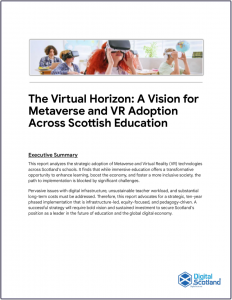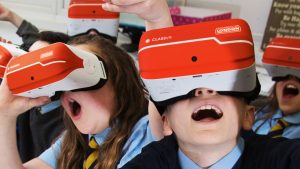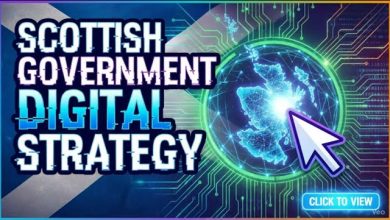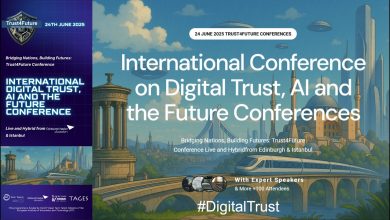Pioneering the Metaverse in Scottish Schools: Immersive Learning for Children
Scottish schools can harness Metaverse virtual worlds—persistent, immersive 3D environments, to pioneer experiential, scalable, and personalized learning models that transcend the limitations of flat video or 2D screens.
 The metaverse—persistent, shared virtual worlds accessed via VR/AR headsets, computers, or mobile devices—is emerging as a transformative tool for digital education.
The metaverse—persistent, shared virtual worlds accessed via VR/AR headsets, computers, or mobile devices—is emerging as a transformative tool for digital education.
By creating immersive 3D environments, it moves learning beyond passive screens and textbooks into experiential, interactive spaces tailored for young learners.
Schools can harness Metaverse virtual worlds—persistent, immersive 3D environments such as Roblox, Decentraland, Spatial, or custom platforms built with Unity or Unreal—to pioneer experiential, scalable, and personalized learning models that transcend the limitations of flat video or 2D screens.
Core Educational Applications
One powerful approach involves historical and scientific simulations, where students step into meticulously recreated 3D environments. They might walk the streets of Ancient Rome in 44 BCE, witnessing Caesar’s assassination from the perspectives of a senator, plebeian, or guard, or shrink to a nanoscale view inside a cell to observe DNA replication in real time.
- Virtual Field Trips and Simulations: Students “visit” ancient Rome, dissect virtual frogs, or explore the human body at cellular scale without leaving the classroom. Platforms like Minecraft Education Edition or Roblox Studio enable history recreations, physics experiments, and ecosystem modeling.
- Collaborative Project-Based Learning: Avatars allow global peer collaboration on shared builds (e.g., designing sustainable cities) or role-playing scenarios (debating as historical figures), fostering social skills and creativity.
- Personalized and Inclusive Pathways: AI-driven avatars adapt content to individual pace and learning styles; VR supports special needs, such as sign-language interpreters or sensory-adjusted environments for neurodiverse students.
These experiences rely on photogrammetry scans, like those used in Rome Reborn, combined with physics engines and AI-driven NPCs powered by GPT-like models to facilitate Socratic questioning.
Key Benefits
Metaverse-based learning innovations enable experiential mastery by letting students learn through risk-free, immersive simulations—like triggering chemical explosions or governing virtual societies—yielding recall rates three times higher than textbooks.
They foster global collaboration at scale, with cross-border teams co-creating in persistent worlds, building cultural competence and real-world teamwork skills.These models deliver personalization and inclusion, using AI to adapt difficulty in real time and sensory controls to support neurodivergent learners, ensuring equitable engagement.
They provide cost-effective access to otherwise impossible experiences, from particle colliders to surgical theaters, democratizing advanced STEM and vocational training without physical risk or expense.
- Engagement and Retention: Studies (e.g., PwC 2021) show VR learners are 4× more focused and retain 75% more information than traditional methods.
- Safe Exploration: Children experiment with high-risk concepts (chemical reactions, space travel) in fail-safe digital sandboxes.
- Equity Potential: Cloud-based access lowers hardware barriers over time, though initial costs remain a hurdle.
By 2030, analysts (McKinsey, Gartner) predict 25% of classrooms will incorporate metaverse elements, driven by falling VR costs and 5G/6G rollout. Success hinges on teacher professional development, evidence-based curricula, and ethical data policies. When implemented thoughtfully, the metaverse shifts education from “learning about” to “learning within,” preparing children for a digitally native future.
 Scottish Pioneers
Scottish Pioneers
In a previous blog we shared a case study about one of the Scottish schools at the forefront of this trend: Erskine Stewart’s Melville Schools, exploring how the school integrates technology to foster innovative, inclusive education.
The goal is to prepare students for a global digital economy by emphasizing self-discovery, critical thinking, collaboration, and experiential learning over traditional rote methods, aligning with Scotland’s vision to become a world-leading digital nation.
The project was led by Simon Luxford-Moore, an EdTech visionary and pioneer who helps education and families leverage technology to maximize learning success.
Luxford-Moore stresses that technology supports—not replaces—learning, valuing the “journey of investigation” over single correct answers. Outcomes include enhanced skills for competitiveness (e.g., against peers in India) and a shift toward education as a collaborative “resource pool” for all Scottish schools.
He envisions a revolutionized Scottish education system harnessing VR and digital creation to level opportunities, foster innovation, and position the nation as a digital powerhouse. By empowering students as creators, ESMS’s model could inspire widespread adoption, preparing a generation for an immersive, interconnected world.



